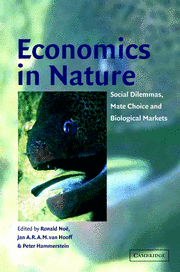Book contents
- Frontmatter
- Contents
- List of contributors
- Preface
- Acknowledgments
- 1 Games and markets: economic behaviour in humans and other animals
- Part I Economic behaviour in social networks
- Part II Biological markets
- Part III Mating markets
- 9 Human mate choice strategies
- 10 How does mate choice contribute to exaggeration and diversity in sexual characters?
- 11 Information about sperm competition and the economics of sperm allocation
- 12 The economics of male mating strategies
- Index
12 - The economics of male mating strategies
Published online by Cambridge University Press: 04 August 2010
- Frontmatter
- Contents
- List of contributors
- Preface
- Acknowledgments
- 1 Games and markets: economic behaviour in humans and other animals
- Part I Economic behaviour in social networks
- Part II Biological markets
- Part III Mating markets
- 9 Human mate choice strategies
- 10 How does mate choice contribute to exaggeration and diversity in sexual characters?
- 11 Information about sperm competition and the economics of sperm allocation
- 12 The economics of male mating strategies
- Index
Summary
The mammalian strategy of internal gestation followed by lactation imposes severe constraints on what males can do in terms of parental investment. This asymmetry in the processes of reproduction results in male mammals placing disproportionate emphasis on mating strategies and less on parental care than is typical of most other taxa. Although male mammals can contribute indirectly to parental care (e.g. by defending a feeding territory for the females(s) or acting as an anti-predator defence), this only remains an option where females can gain a net benefit from associating with males relative to the foraging costs that additional animals must inevitably impose on them.
This asymmetry in reproductive biology has one important implication for mammalian social systems. In birds, it is not uncommon for males to arrive first on the breeding ground.Having partitioned the available space among themselves, they settle on their territories to await the arrival of the females who then choose among them. While a similar pattern can be observed in those mammals that adopt a lek mating system (notably some deer, antelope and pinnipeds), the reverse is probably more typical of many mammals (and most primates). In a classic experiment, Charles- Dominique (1977) released a number of dwarf galago (Galago demidorvii) into a forest in Gabon. He found that the population developed its own natural structure in a surprisingly ordered manner. First, the females established their ranges; once they had decided how to distribute themselves, the males then mapped themselves onto the female distribution.
- Type
- Chapter
- Information
- Economics in NatureSocial Dilemmas, Mate Choice and Biological Markets, pp. 245 - 269Publisher: Cambridge University PressPrint publication year: 2001
- 4
- Cited by

